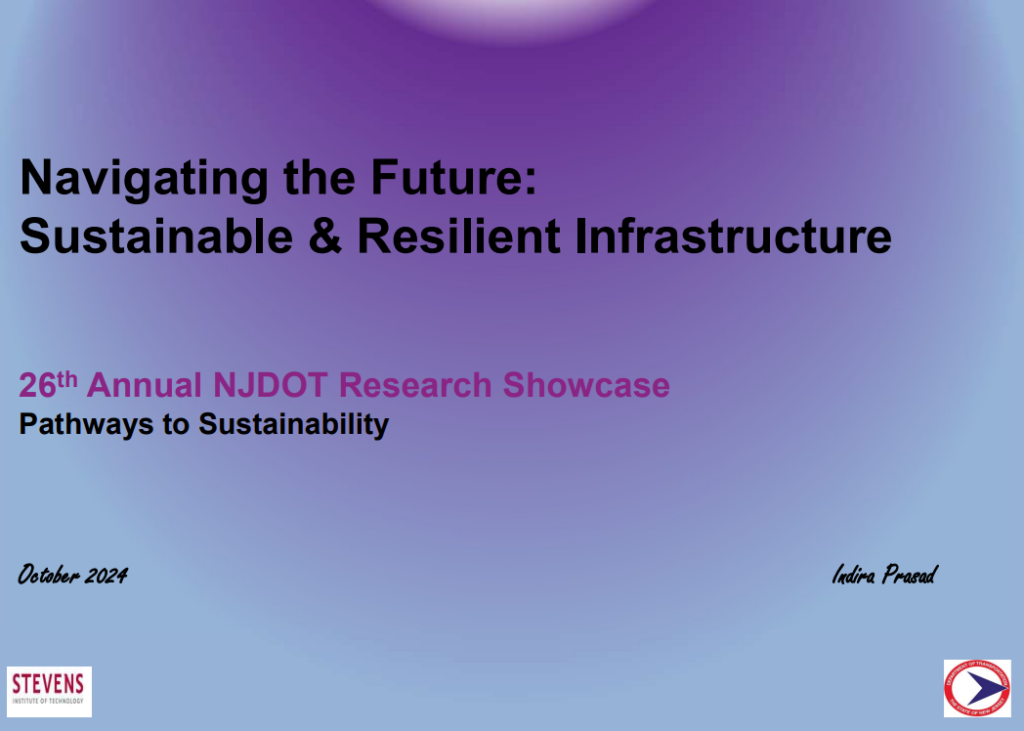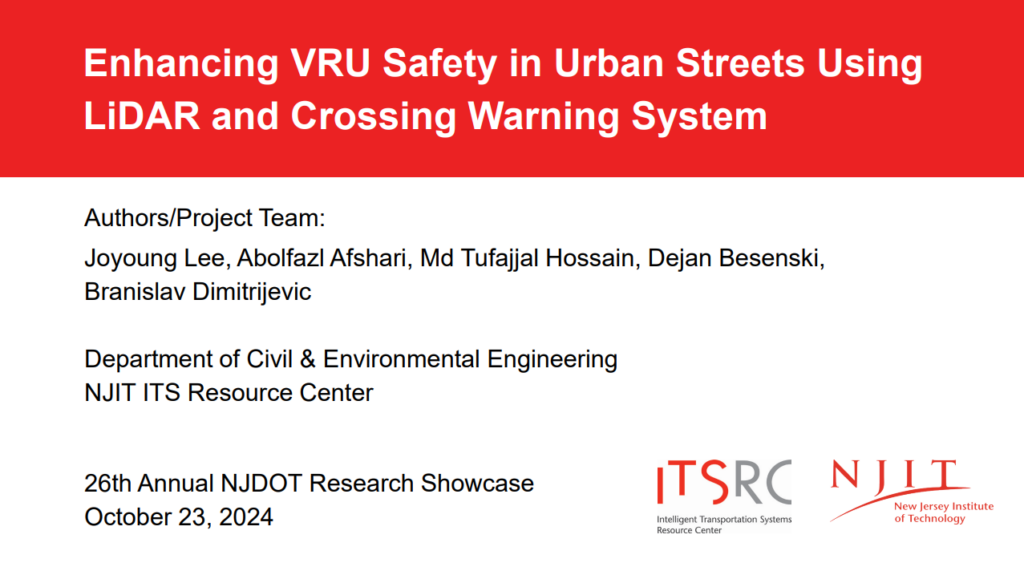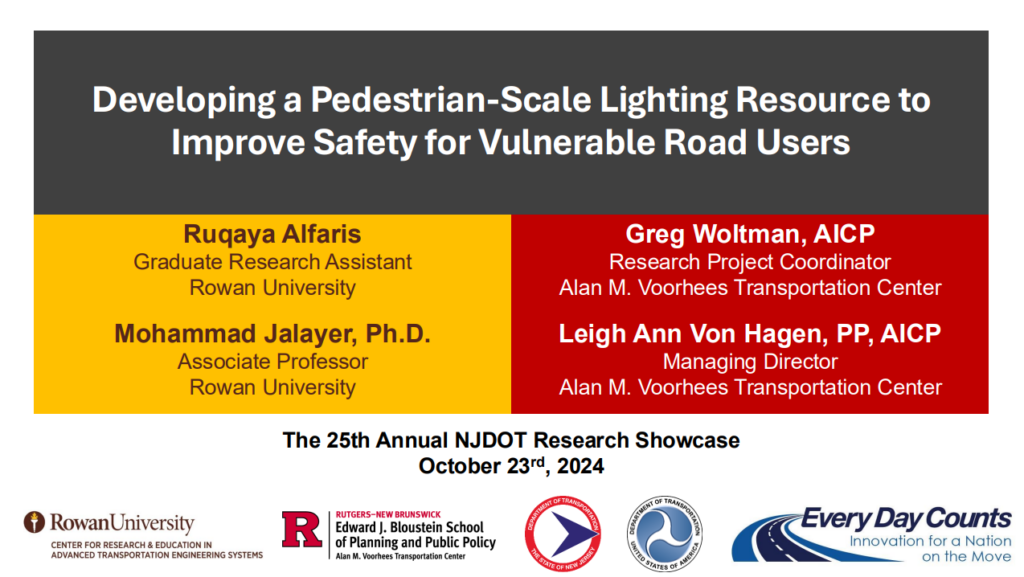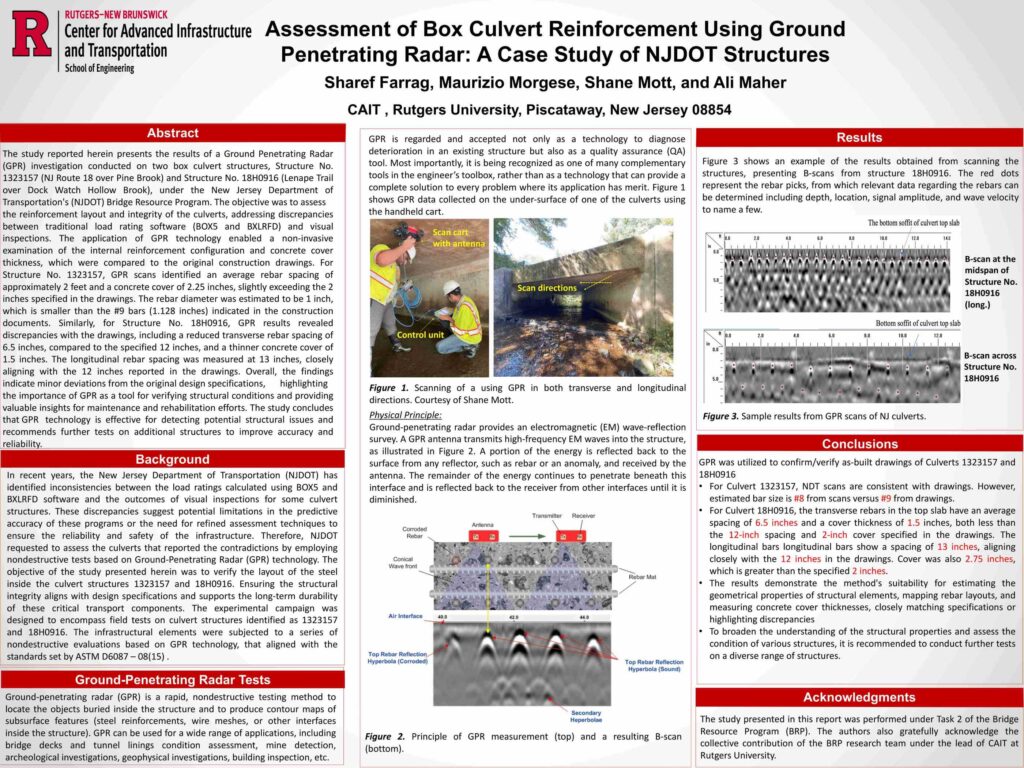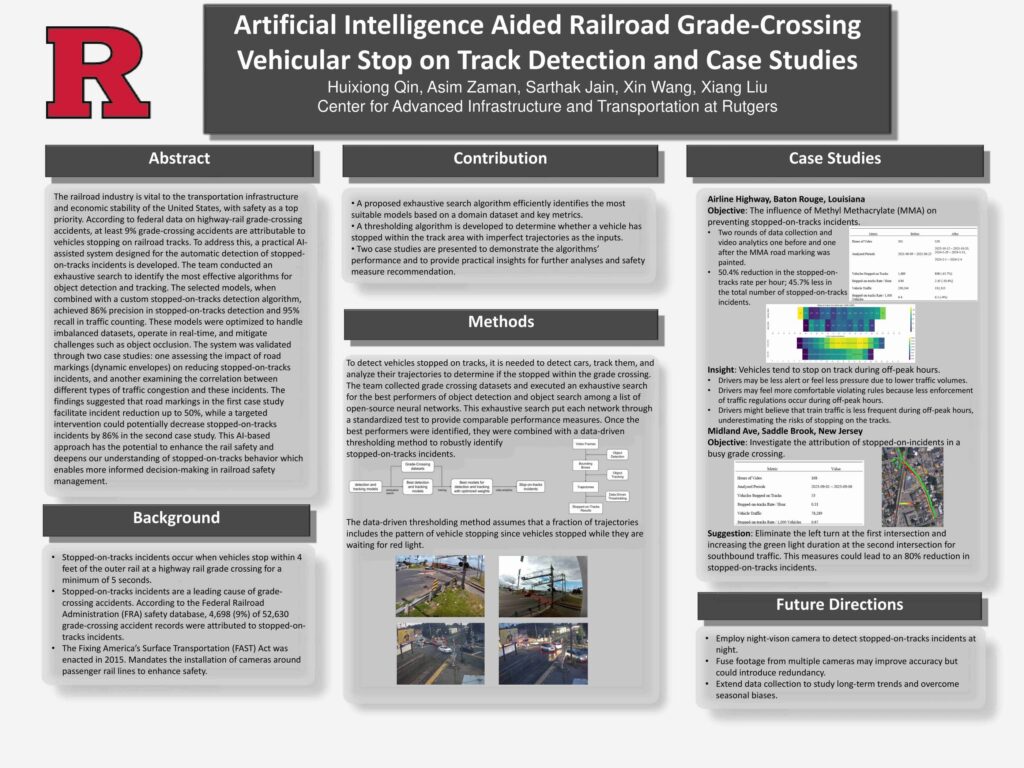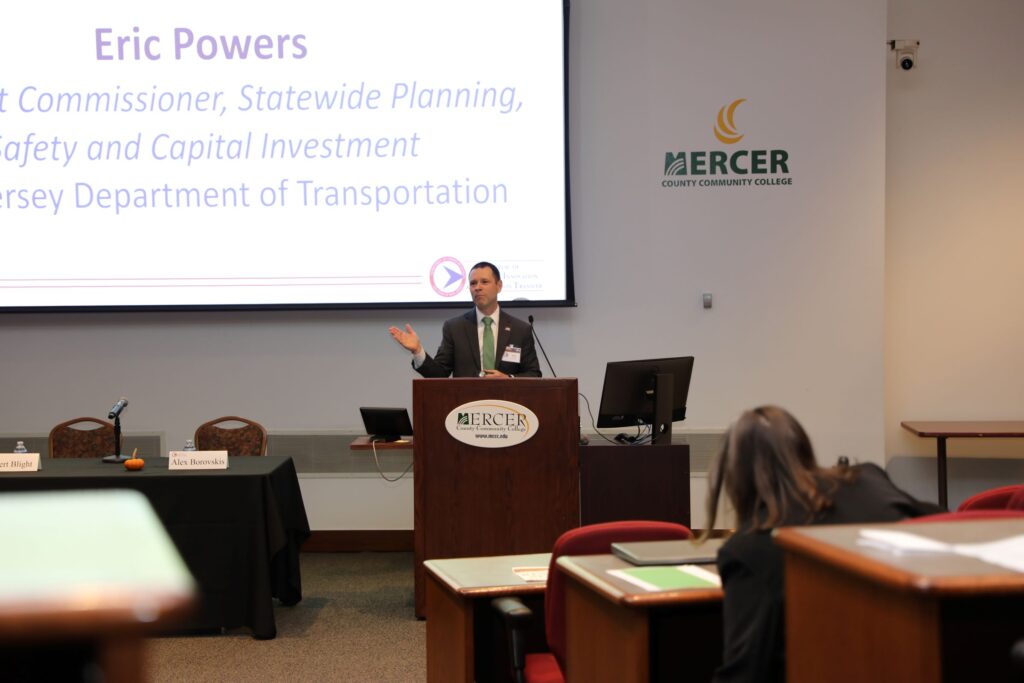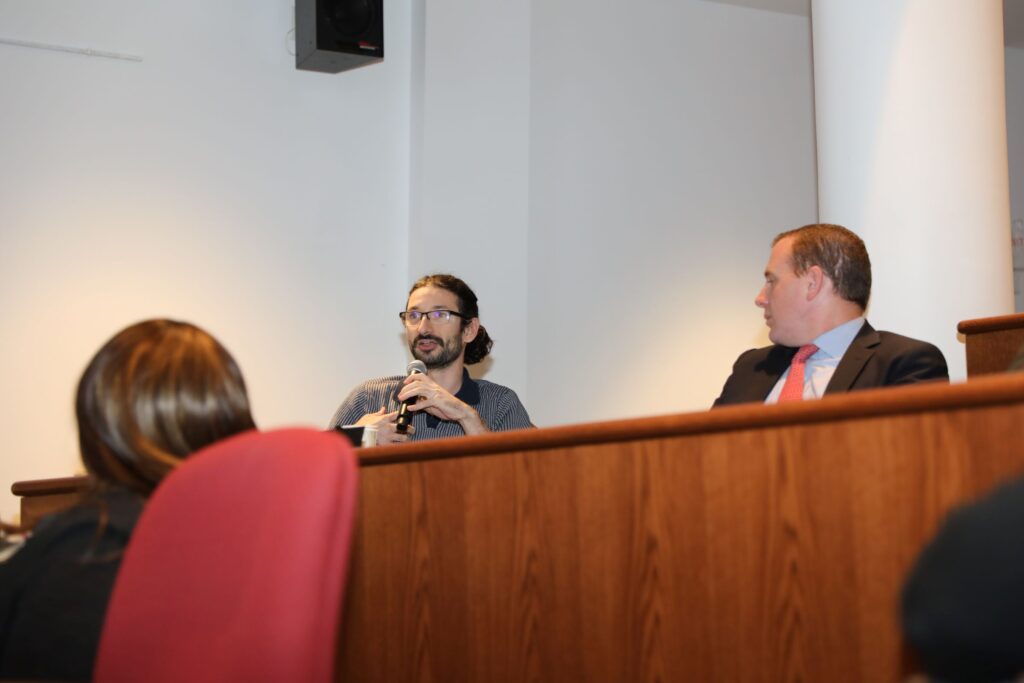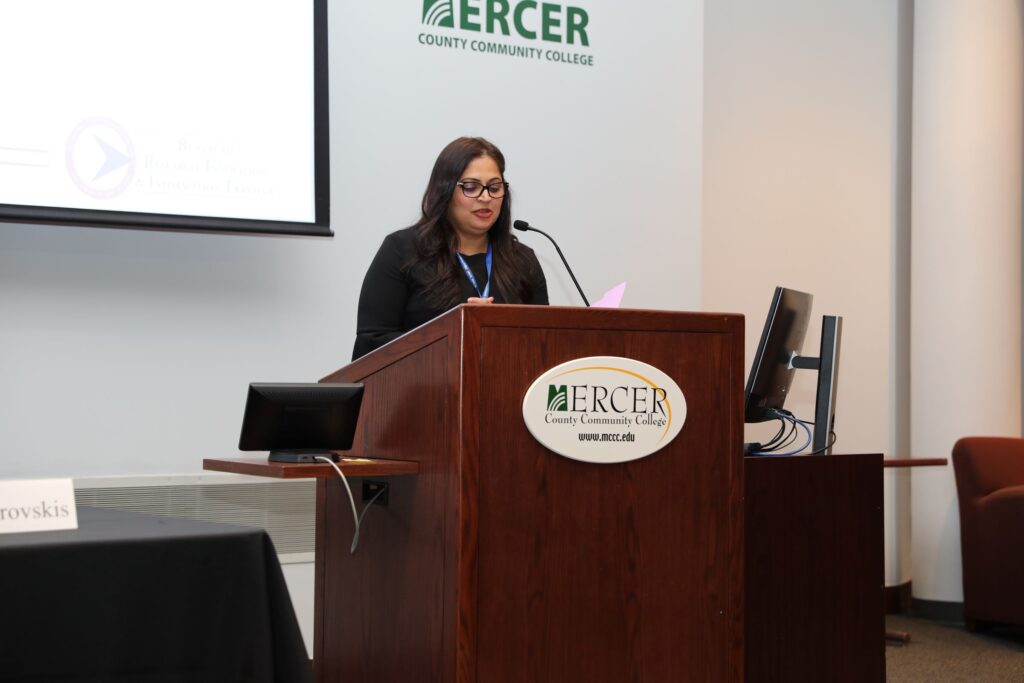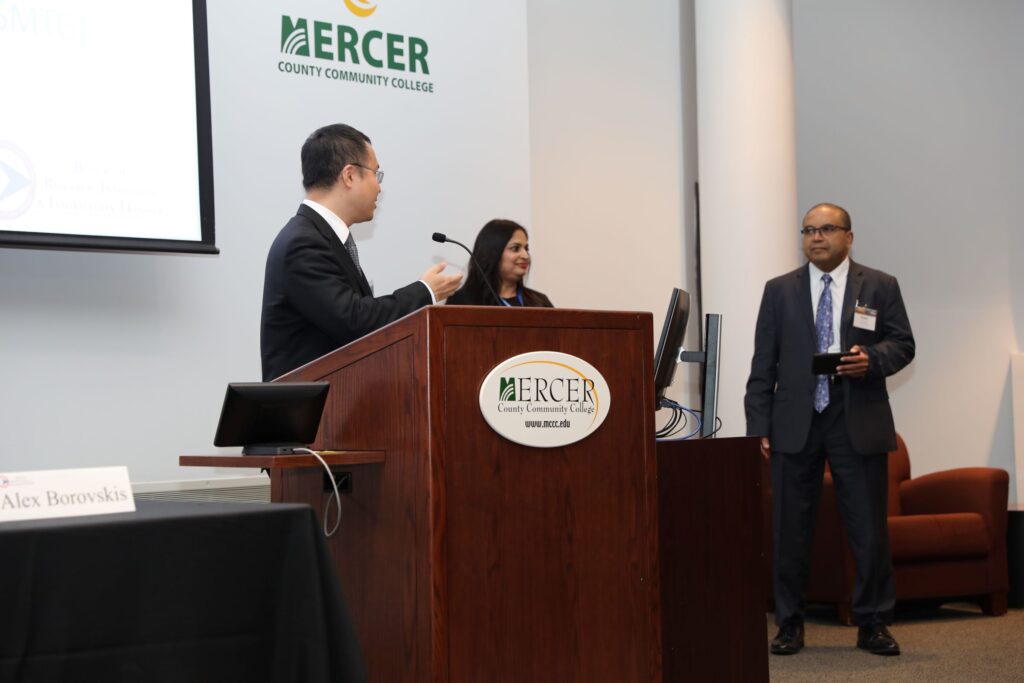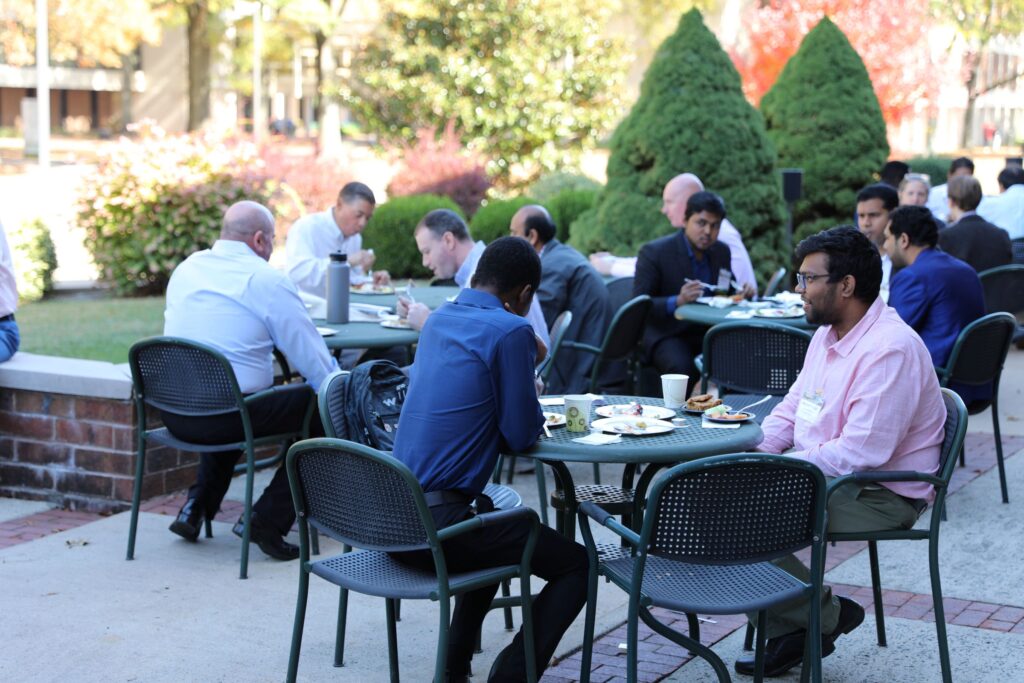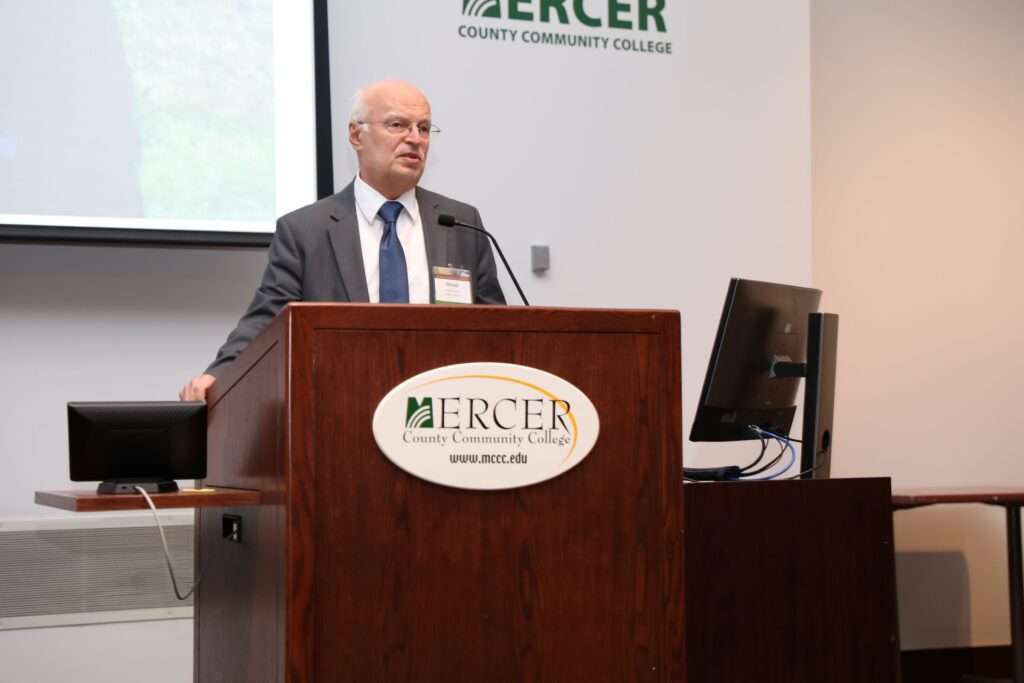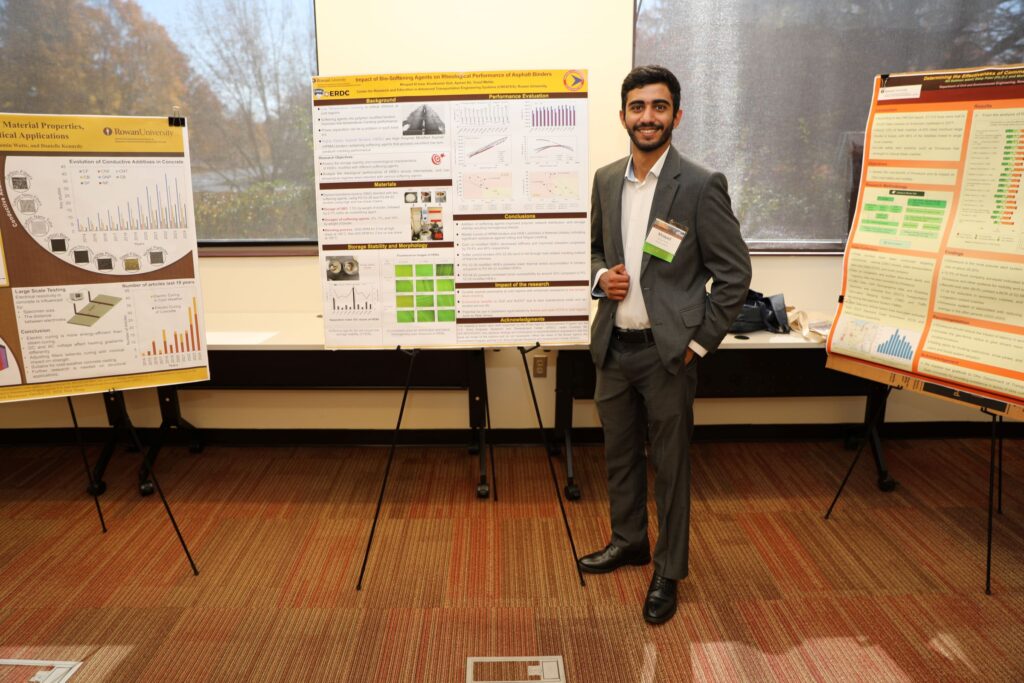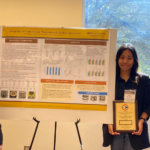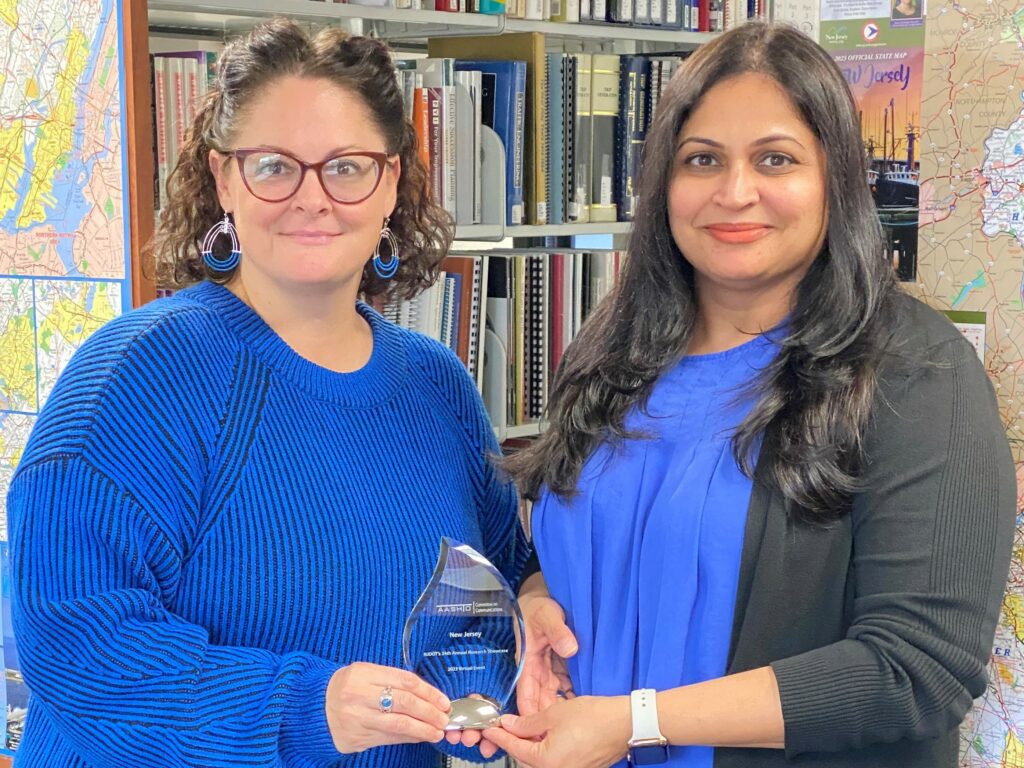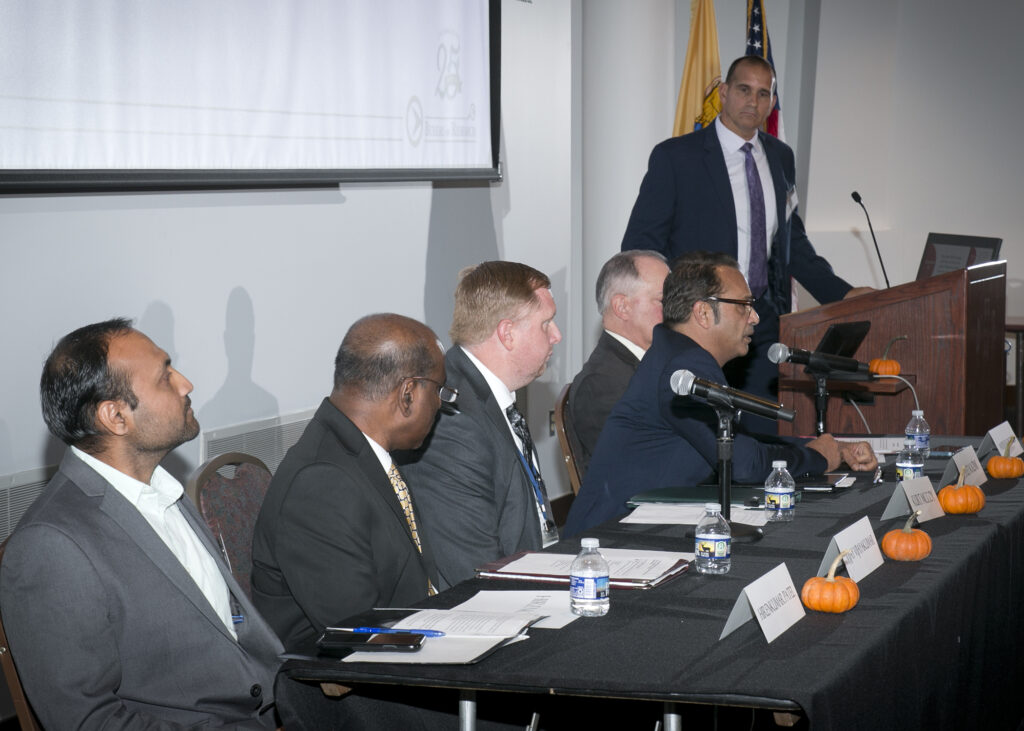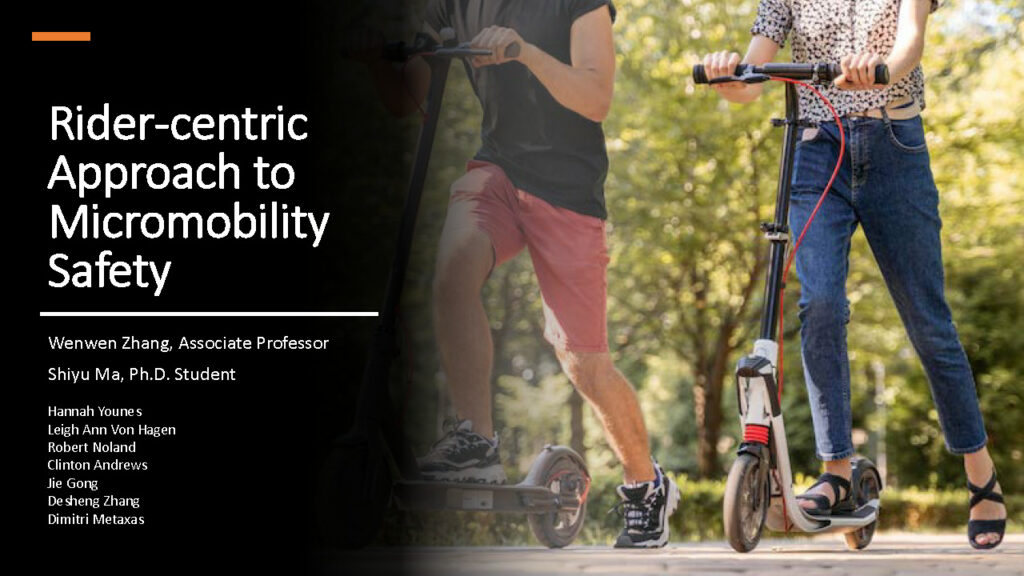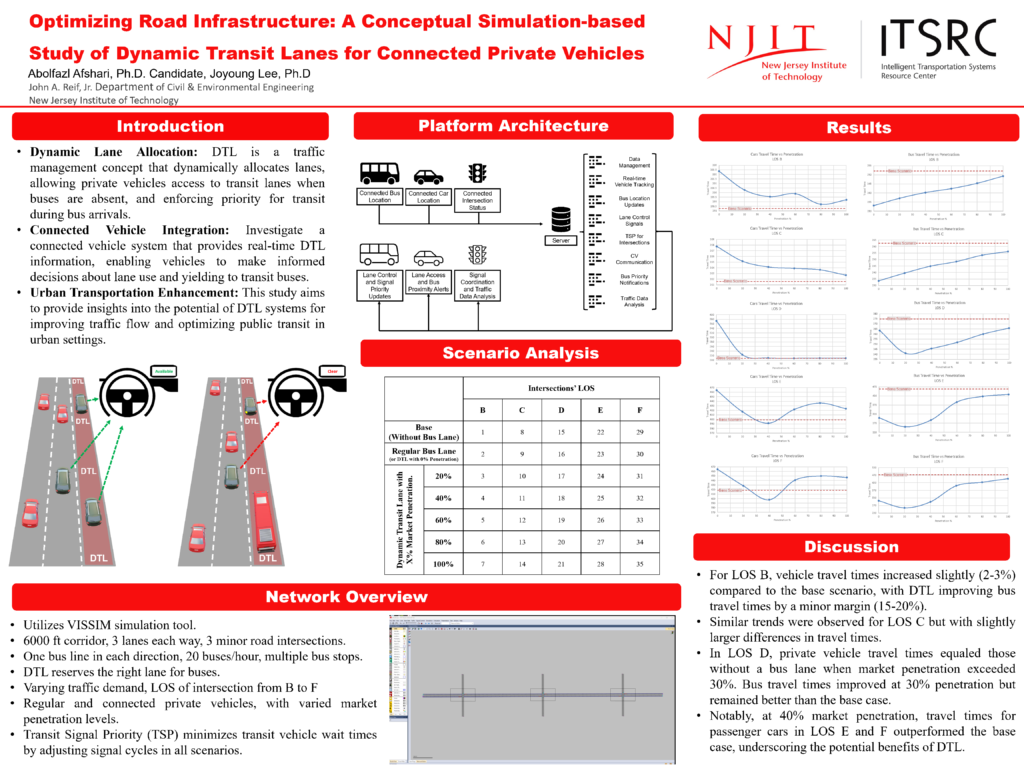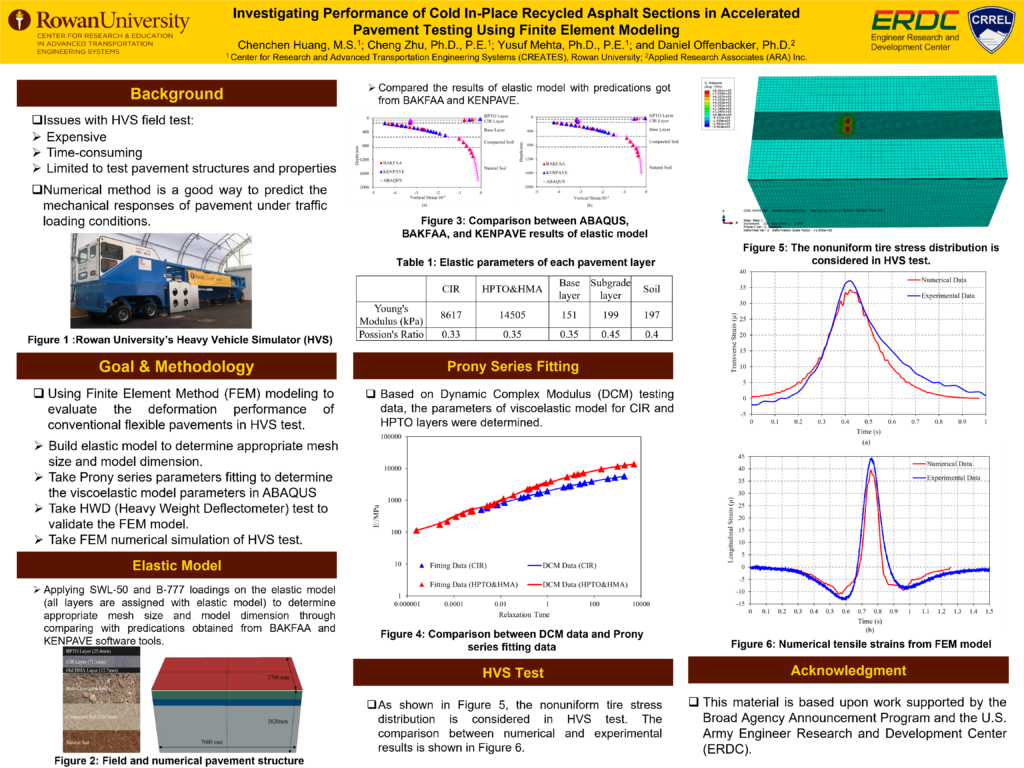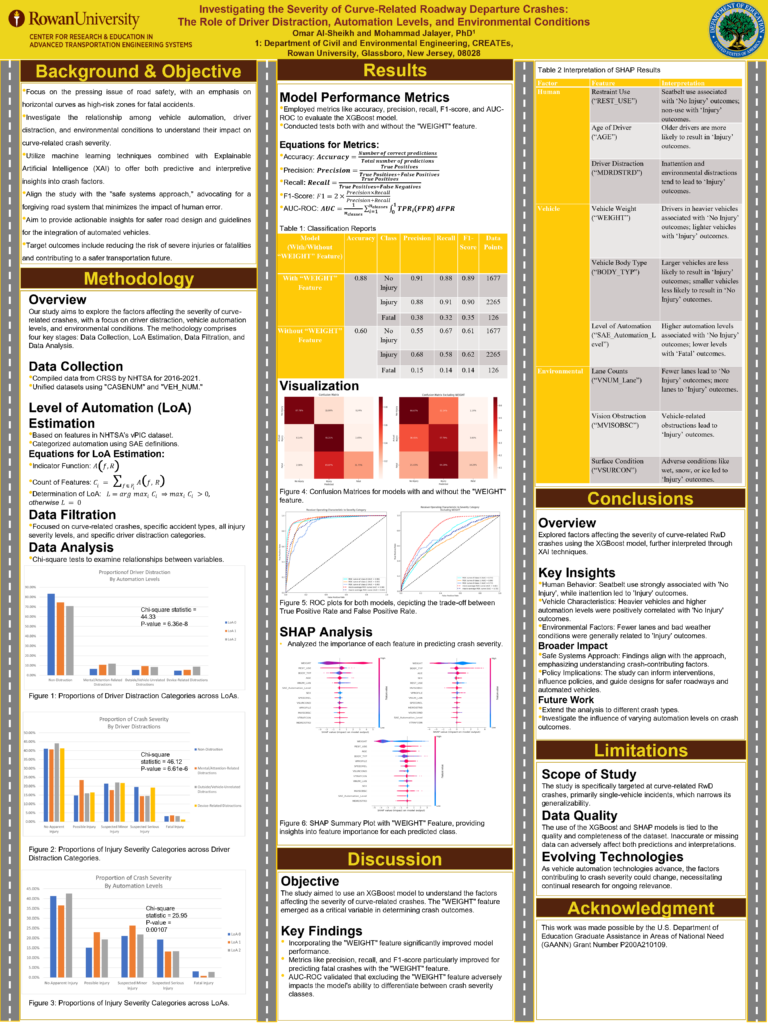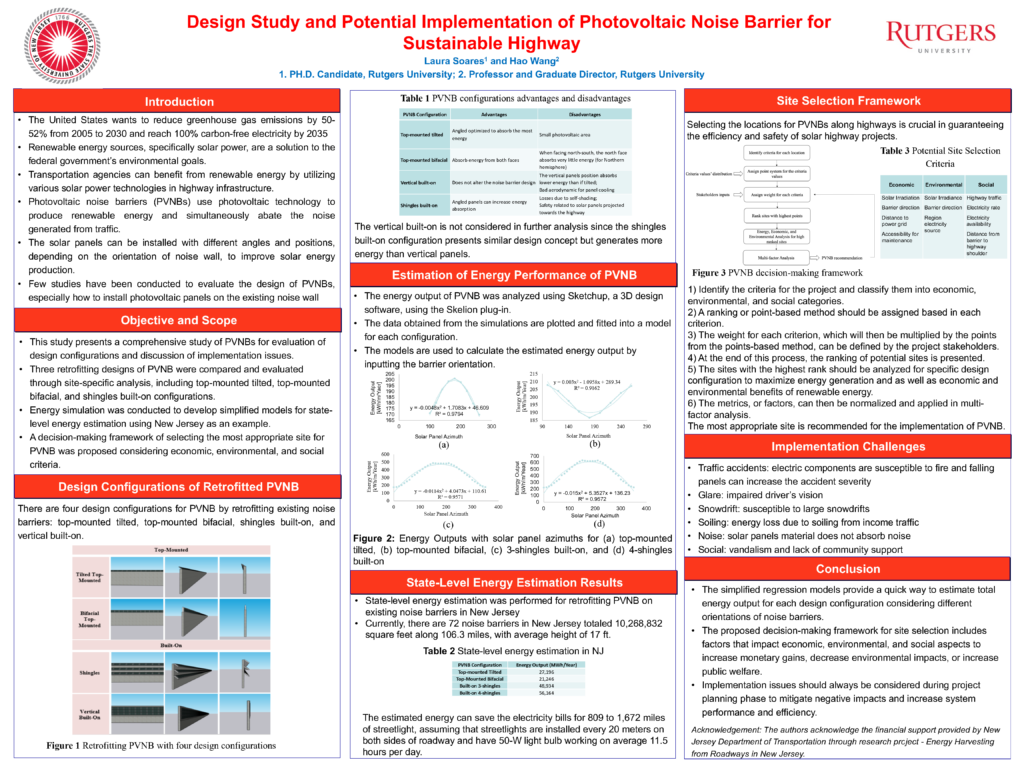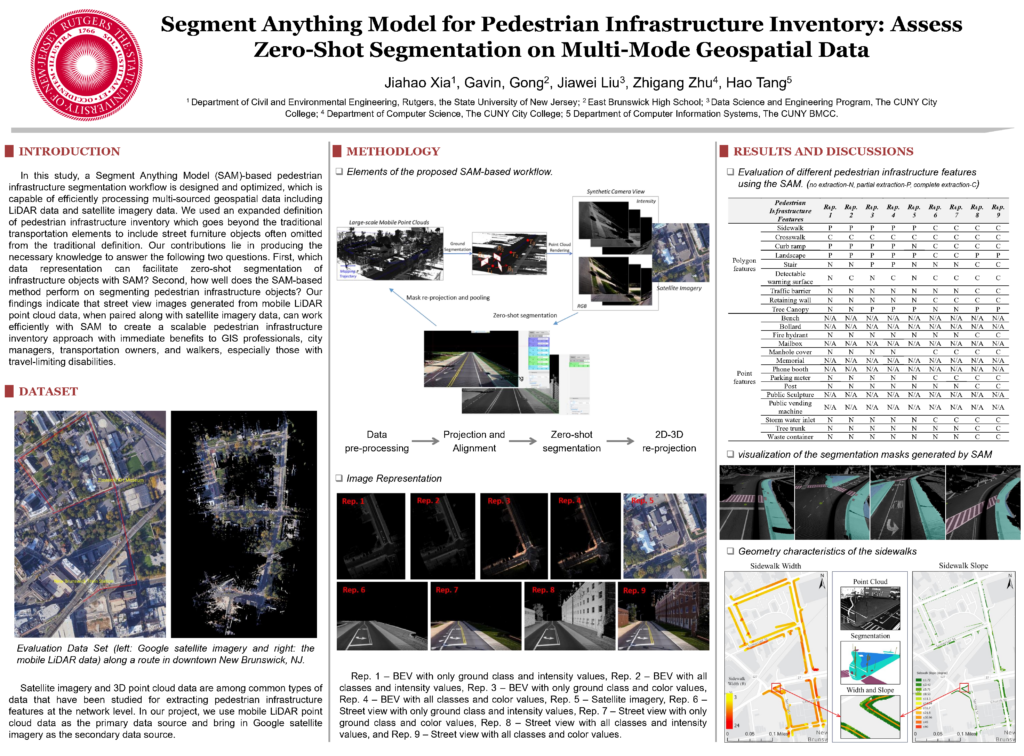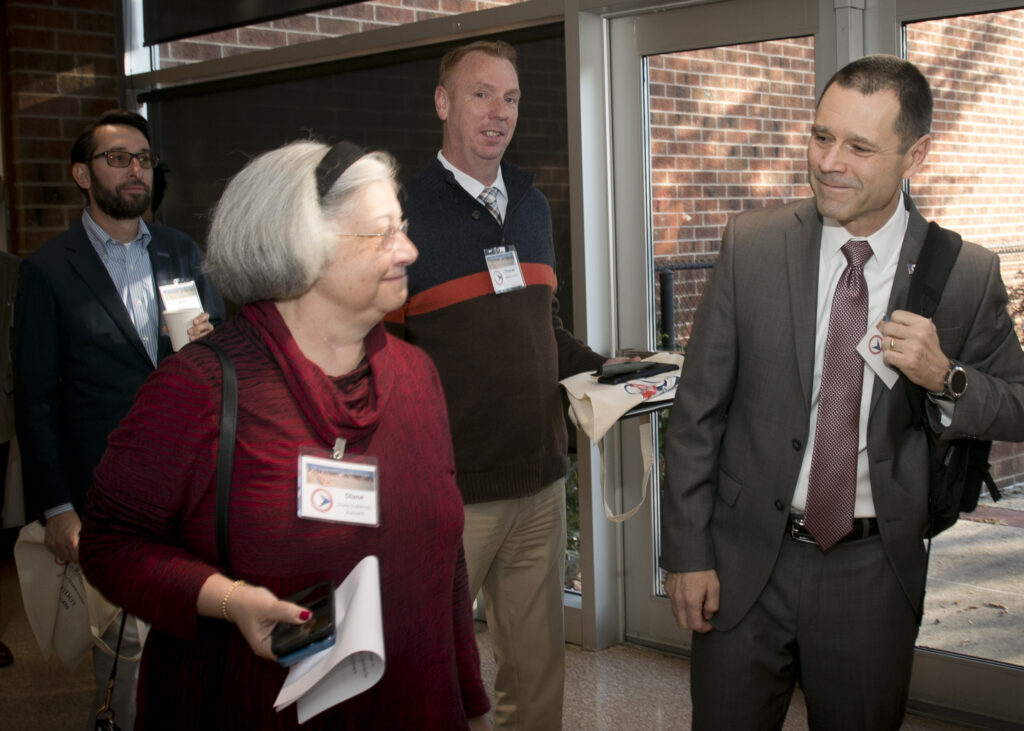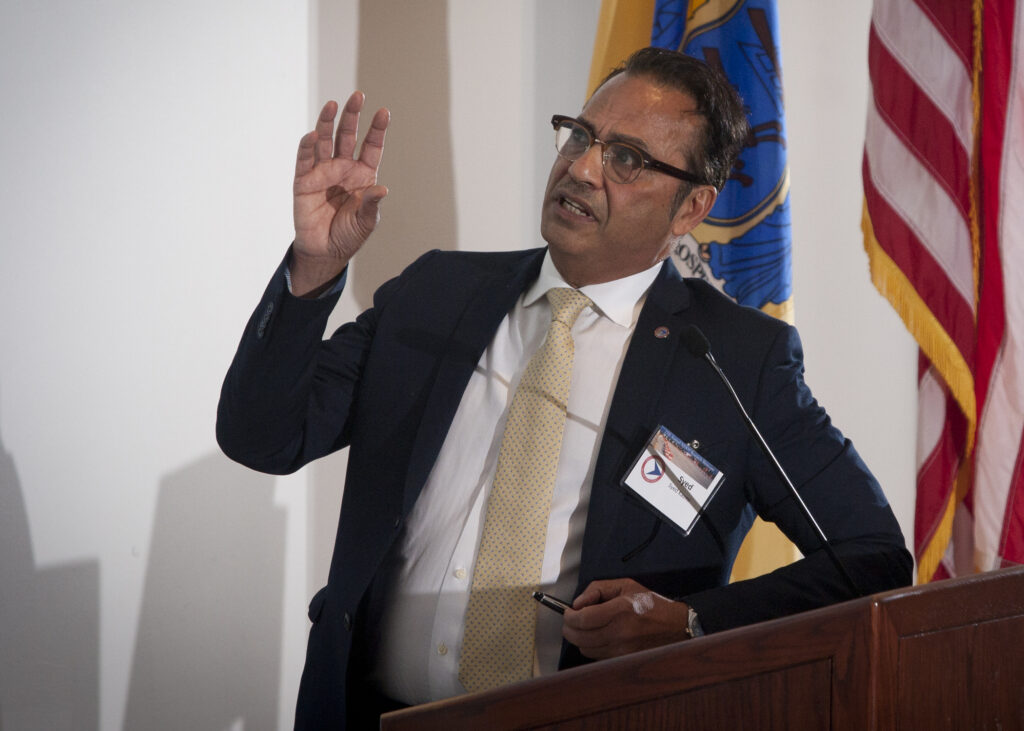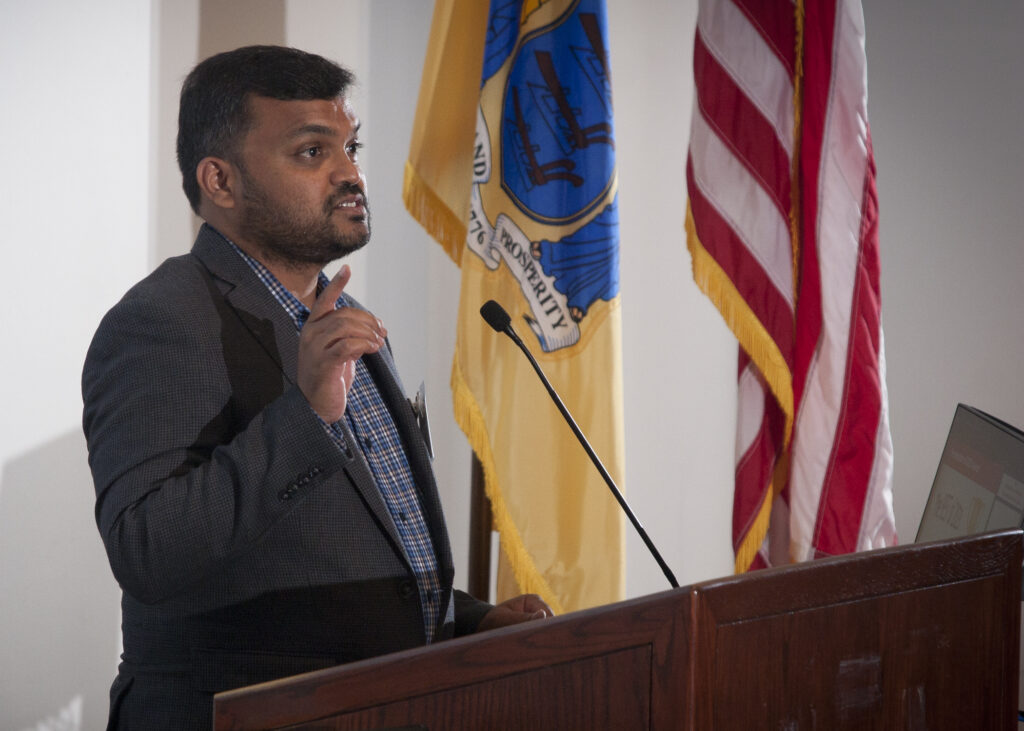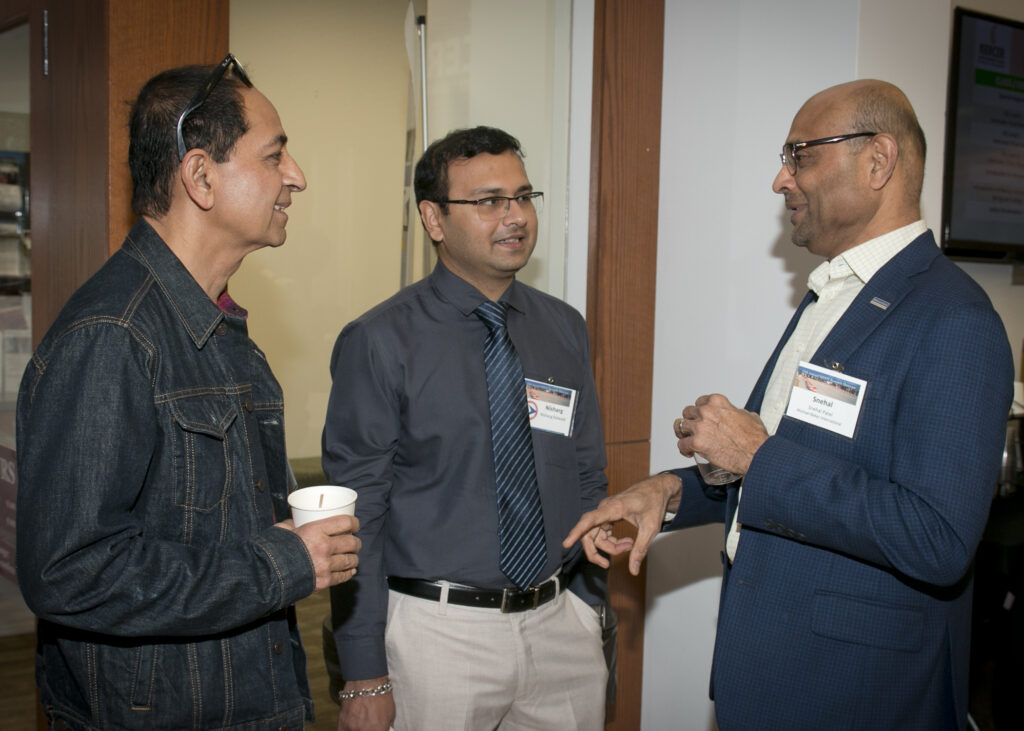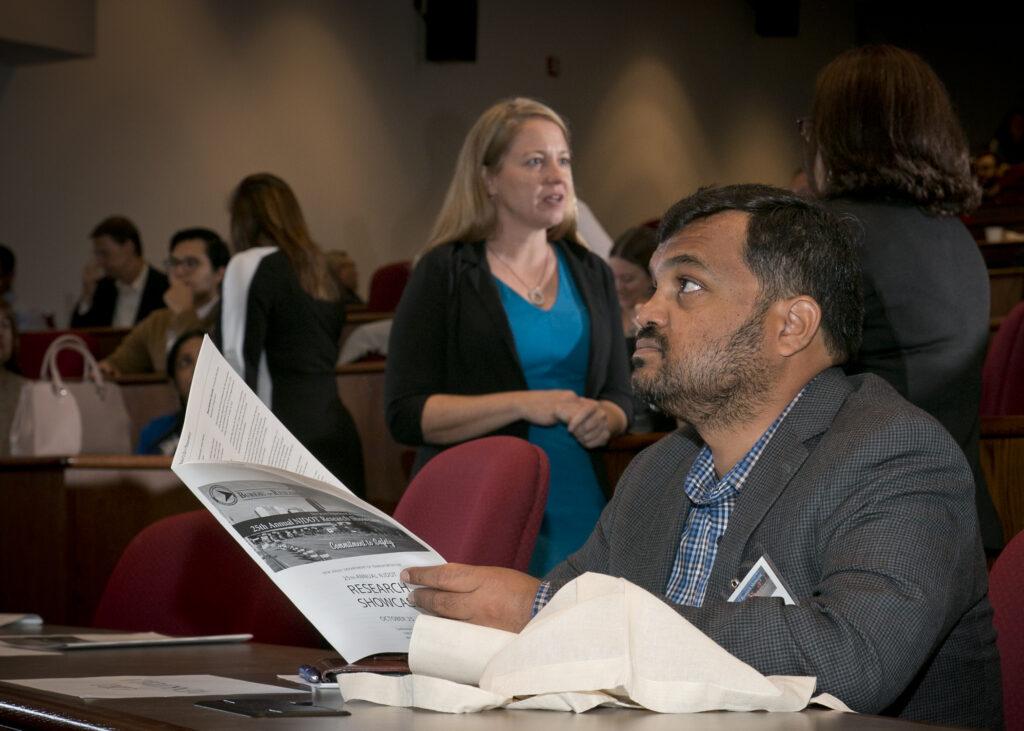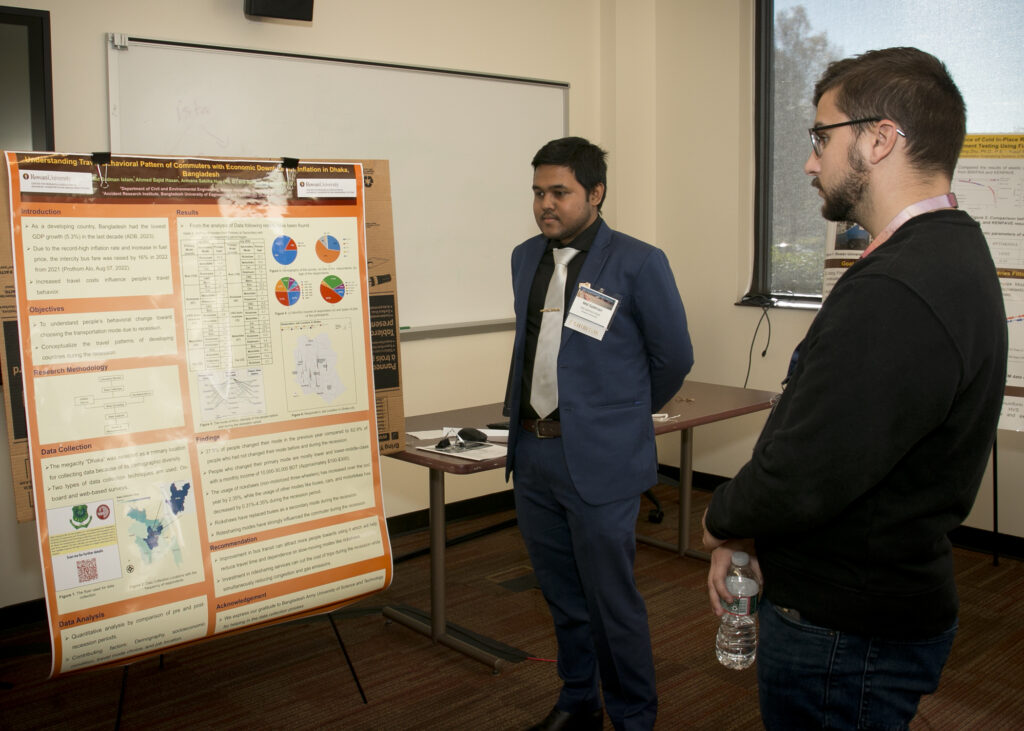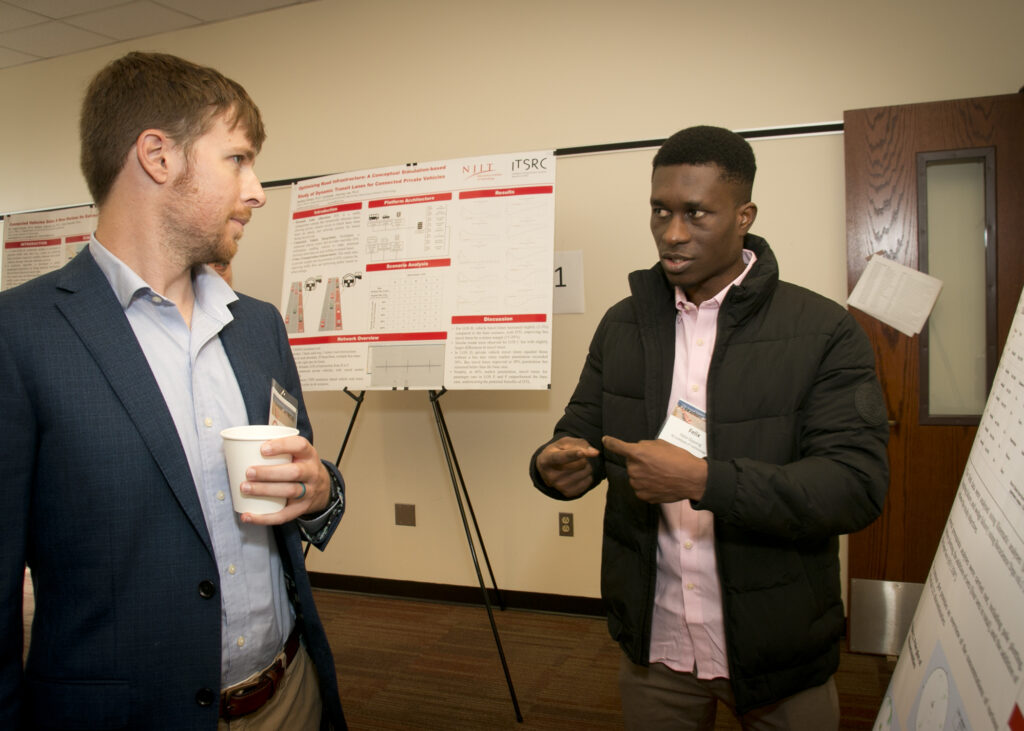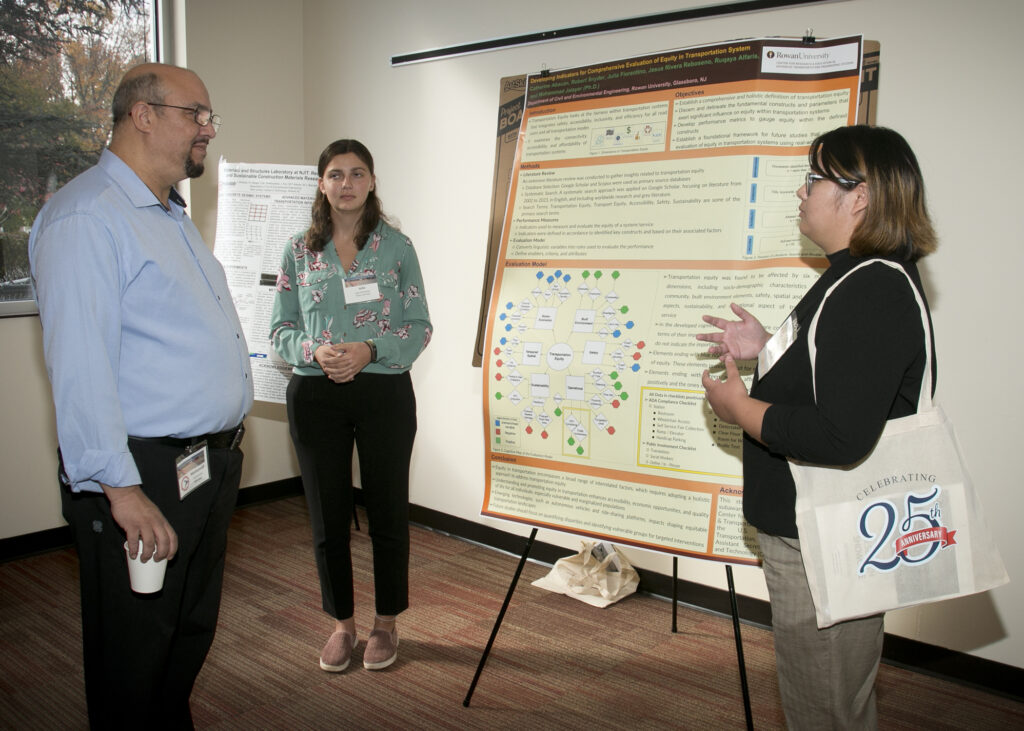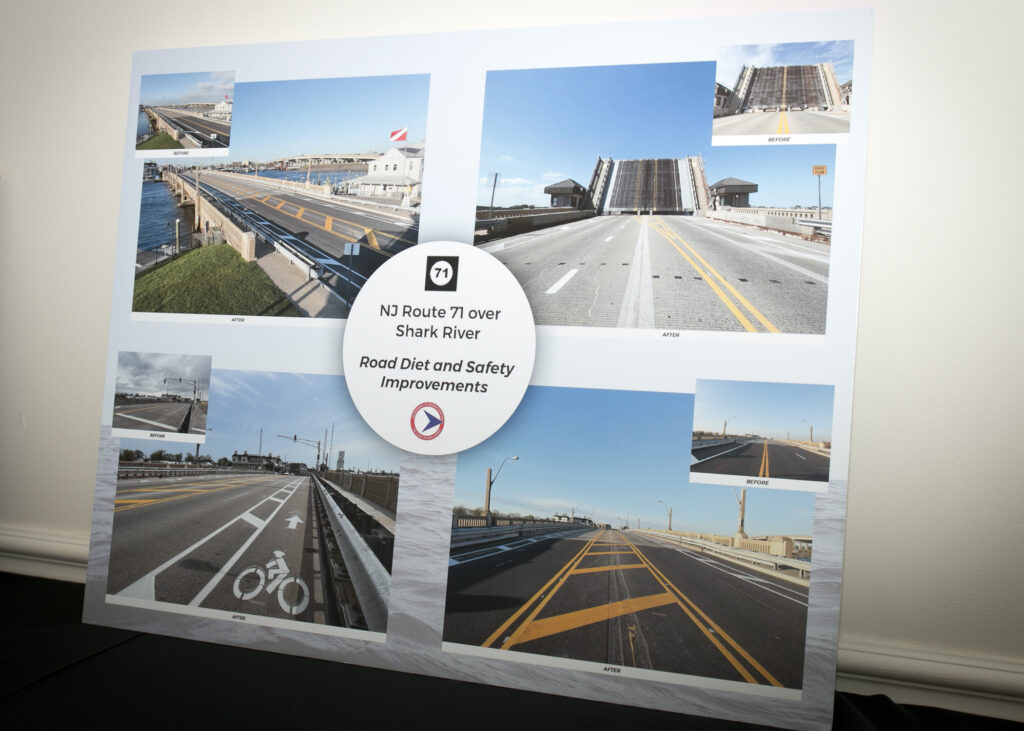The 26th Annual NJDOT Research Showcase provided an opportunity for the New Jersey transportation community to learn more about the broad scope of research projects and technology transfer activities being conducted by institutions of higher education partners and their associates. The annual event serves as a showcase to highlight the benefits of transportation research, including NJDOT’s own program. This event was an in-person event with a livestreaming option with sessions held from 9:00am-2:45pm on October 23, 2024.
This year’s Showcase theme, “Pathways to Sustainability,” served as the organizing framework for the speakers and panelists during the morning plenary session. Throughout the day the Research Showcase featured presentations on infrastructure, safety, and sustainability topics being performed by research faculty, staff, students, and NJ agencies. Several awards were presented in recognition of research and implemented innovations.
The Research Showcase Program Agenda provides more information on the day’s proceedings, including presented topics and invited speakers. Recordings of the plenary and breakout sessions, and the presentations and posters shared during the event can be found below.
MORNING
WELCOMING AND INTRODUCTORY REMARKS
David Maruca, Program Development Administrator, Rutgers Center for Advanced Infrastructure and Transportation (CAIT), served as the moderator for the morning session, offering some housekeeping remarks and walked through the morning’s agenda.
Eric Powers, Assistant Commissioner Statewide Planning, Safety and Capital Investment at NJDOT, welcomed attendees to the 26th Annual NJDOT Research Showcase, explaining the purpose and theme of the event, “Pathways to Sustainability,” and acknowledging several parties, including NJDOT Bureau of Research, Innovation and Information Transfer (BRIIT) staff, Rutgers-CAIT, and the leadership of NJDOT and FHWA for their planning and participation in the day’s event along with the research partners whose work was being showcased.
Francis O’Connor, Commissioner, NJDOT, thanked several partners for their involvement in organizing the Research Showcase event. He expressed his enthusiasm for the research mission, noting that research is at the heart of progress for innovation in transportation. He framed the event as an opportunity to convene and collaborate with talented researchers and staff in tackling challenges that still confront us in transportation. Mr. O’Connor spoke about the day’s sustainability theme and emphasized the integral importance of safety in all that the agency does. The recent actions by NJDOT to improve safety for all road users, and the NJDOT highway workforce were highlighted by the Commissioner, among other topics.

Sutapa Bandyopadhyay, Planning and Program Development Manager, Federal Highway Administration (FHWA) New Jersey Division, praised the NJDOT Research Showcase’s “Pathways to Sustainability” theme and noted its close alignment with FHWA’s newest strategic plan which contains climate and sustainability as a core goal. She spoke of the strategic plan’s focus on greenhouse gas (GHG) emissions reduction and resilient infrastructure. She highlighted select formula and discretionary programs supported through the Infrastructure Investment and Jobs Act (IIJA), including the Carbon Reduction Program, the National Electric Vehicle Infrastructure (NEVI) deployment, and discretionary programs to reduce truck emissions in port facilities. In her remarks, she also emphasized the importance of research to assist in supporting the current administration’s major planning goals and targets (e.g, net-zero carbon emissions by 2050, adoption of resiliency plans by 50% of the states and MPOs by 2026, and 40 percent of the transportation clean energy benefits delivered to disadvantaged communities in alignment with the Justice40 initiative).
KEYNOTE ADDRESS
Jim Tymon, Executive Director at American Association of State Highway and Transportation Officials (AASHTO) provided the keynote address, “Navigating the Storm: Resilience, Sustainability and Surface Transportation”. His address reminded those in attendance of the importance of collaboration in continuing to build a resilient and sustainable transportation network.
Mr. Tymon began his talk by introducing AASHTO, a multi-modal focused trade association that works with 52 state DOTs (including D.C. and Puerto Rico) to provide codified guidance and a platform for sharing knowledge. AASHTO is governed by a strategic plan, created in 2020, that expands their focus beyond the technical goals of transportation to developing “quality of life through strategic leadership”.
AASHTO hosts over thirty different committees and councils in which state DOTs can learn from each other’s experiences. Tymon’s remarked that AASHTO’s President has coined this process as “R&D” — or rip-off and duplicate. This form of “R&D” keeps departments from having to re-invent the wheel themselves and often leads to more successful outcomes.
This collaboration, he pointed out, is necessary for navigating the storm of increased climate disasters and unpredictable weather conditions. In the transportation field, the effects of climate change are both economically devastating and logistically challenging to address. In 2023 alone, climate related disasters cost the U.S. at least $92.9 billion in damages and in the past forty-three years, there have been 376 disasters, each costing over $1 billion. He stated, “Whether or not you are a climate change denier, or somebody that believes in the fact that our climate is changing, we have events that we are dealing with on a regular basis that we need to adapt to and that we need to take into account as we are dealing with our transportation network”.
Mr. Tymon proceeded with additional data and statistics to illustrate how State DOTs were fiscally impacted by the storms. Mr. Tymon laid out two avenues of solutions for addressing this growing issue: 1) building a more resilient transportation system; and 2) building a more sustainable transportation system.


To build a resilient transportation system and network, Mr. Tymon recommended deeply considering how we are designing and building transportation systems and taking into consideration a variety of changing climate factors. Mr. Tymon presented the Resilience Planning Cycle from the Port Authority of New York and New Jersey as a model for this type of planning. Fortunately, there is a variety of federal assistance programming available through the Infrastructure Investment and Job Act, including the PROTECT program. PROTECT (Promoting Resilient Operations for Transformative, Efficient, and Cost-saving Transportation) is a formula program that is given annually to each state to use for state resilience projects. This funding can also assist States with the development of a state Resilience Improvement Plan, which is not a requirement, but does ensure a higher federal match.
Mr. Tymon’s second recommendation, to build a more sustainable transportation system, can be made possible through intentional efforts such as encouraging a modal shift by transportation users. He noted that encouraging a shift of transportation usage from single use cars to buses, trains, walking, cycling, or using more fuel-efficient cars, can help to reduce carbon emissions that may slow the effects of climate change.
AASHTO recently assisted with the administration’s U.S. National Blueprint for Transportation Decarbonization, which laid out guidance for decarbonizing the transportation network. He highlighted several methods in the Blueprint from planning and leveraging telework, to e-commerce and travel demand management. State agencies receive financial support for developing carbon reduction strategies through programs like the Carbon Reduction Program as well as the National EV Infrastructure Program (NEVI).
Mr. Tymon closed his talk by sharing a recent commercial created by the Tennessee Department of Transportation which aired during a recent football game between Florida and Tennessee. The video highlighted the collective rebuilding and road improvement efforts of Tennessee DOT and Florida DOT volunteers in the wake of Hurricane Helene. Mr. Tymon explained that prior to landfall, Hurricane Helene was expected to impact Florida greatly. To help, Tennessee DOT members were preparing to travel down to Florida in its wake. Instead, when Tennessee became more impacted because of the Hurricane, Florida DOT employees traveled up to Tennessee to help. The video and situation, Mr. Tymon noted, represents how state DOTs “can work together to help mitigate some of those impacts (climate change) and recover.”
Mr. Tymon responded to questions in the Q&A session that followed his keynote remarks.
MORNING SESSION PANEL DISCUSSION
An interactive panel discussion, “How is New Jersey Department of Transportation Creating Pathways to Sustainability?” followed the keynote session. NJDOT staff representatives presented several examples of sustainability initiatives underway at NJDOT in various areas including construction and materials selection, pavement preservation, transportation planning, project management and research. The presenters reflected on the opportunities and persistent challenges as well as the benefits of addressing sustainability in New Jersey.
The panelists included:
- Alex Borovskis, Director, New Jersey Department of Transportation Division of Construction and Materials
- Robert Blight, Executive Manager, New Jersey Department of Transportation Division of Pavement & Drainage Management and Technology Bureau
- Krishna Tripathi, Project Management Specialist, New Jersey Department of Transportation Division of Project Management
- Mohab Hussein, Supervising Engineer, New Jersey Department of Transportation Bureau of Structural Design & Geotechnical Engineering
- Sushant Dargi, Principal Engineer, Planning, New Jersey Department of Transportation Bureau of Statewide Strategies
- Giri Ventikeela, Innovation Officer, Bureau of Research, Innovation & Information Transfer
Participants responded to a series of questions posed by the moderator and by the audience members.
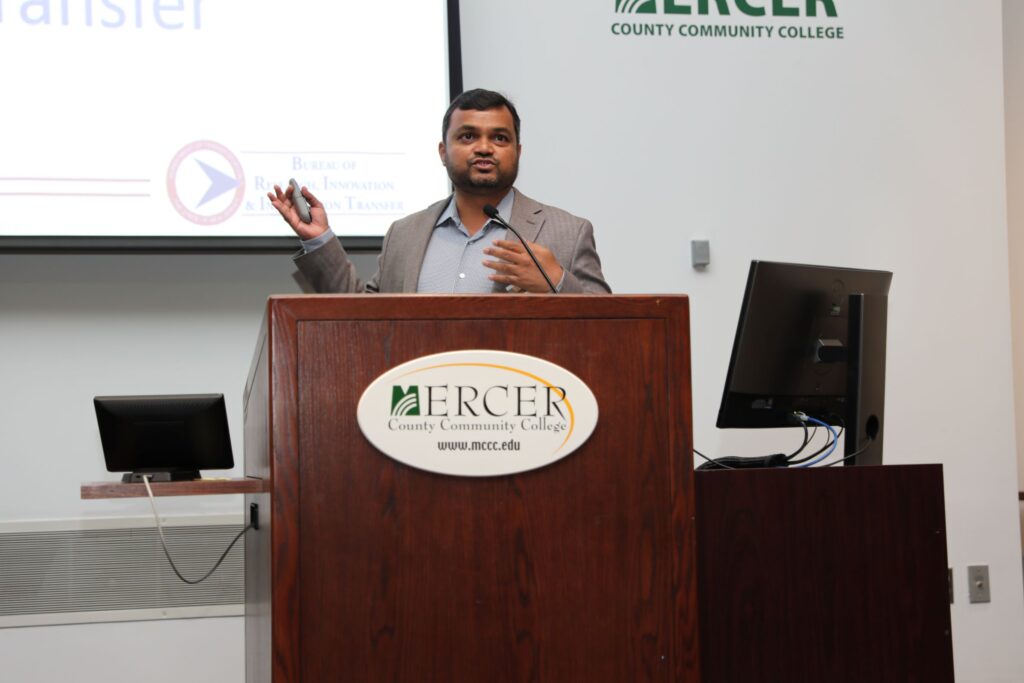

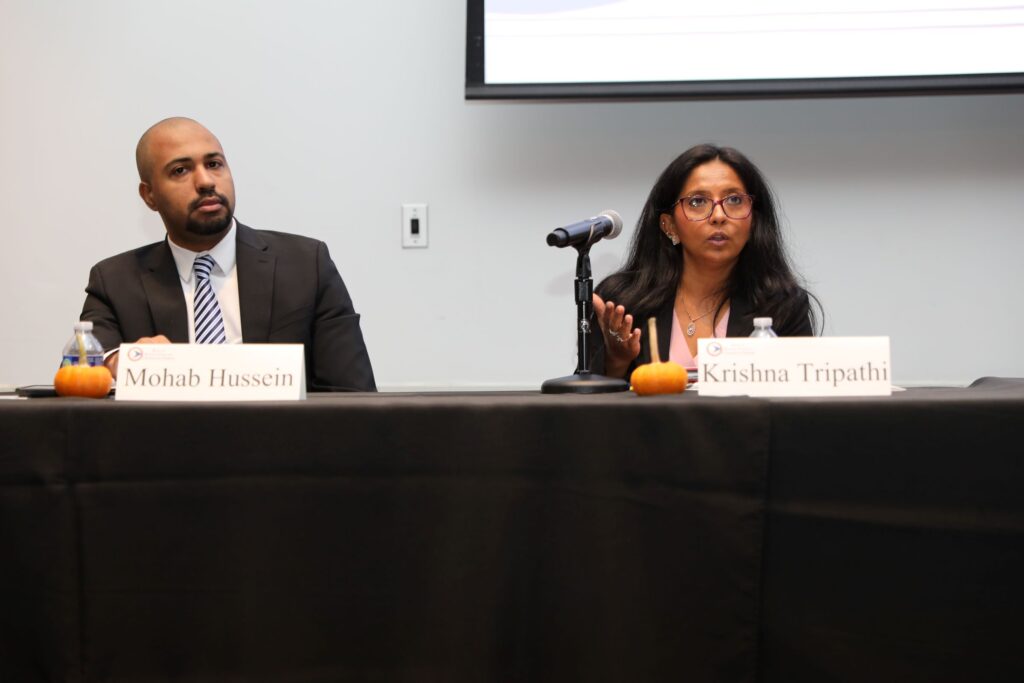


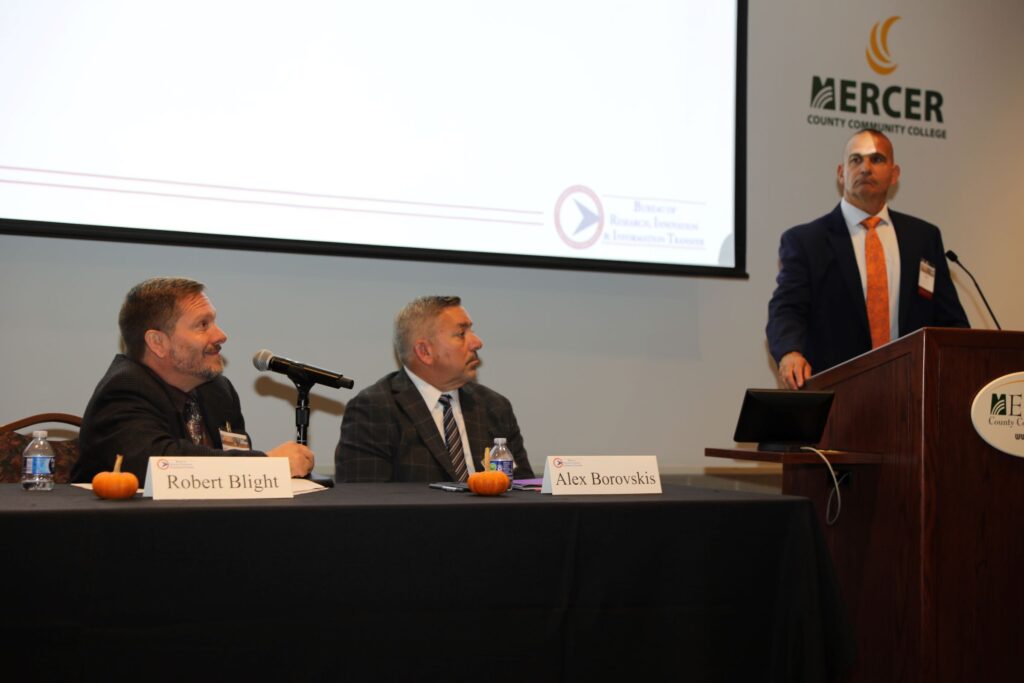
Panelists shared their views on how the New Jersey Department of Transportation is creating pathways to sustainability.
AWARDS
The program continued as Pragna Shah, New Jersey Department of Transportation, announced several awards given in recognition of research, innovation and implementation efforts. Below is a listing of the award winners presented at this year’s showcase:
2024 Outstanding University Student in Transportation Research Award – Deep Patel, Rowan University. Mr. Patel received the award for his valued contributions to research on “Real-Time Traffic Signal System Performance Measurement” through successive phases and several other recent and ongoing NJDOT projects.
2024 NJDOT Research Implementation Award – Dr. Peter Jin, Rutgers University, New Brunswick Innovation Hub Smart Mobility Testing Ground (Data City SMTG). This project, partially funded by NJDOT, generated a living laboratory for transportation data collection and smart technology innovation across a 2.4-mile multi-modal corridor in New Brunswick.
2024 Best Poster Award – Swathi Malluru, Rowan University, Performance Evaluation of Full-Depth Reclamation and Cold In-Place Recycling Asphalt Mixtures at Varying Amounts of Bituminous and Cementitious Additives. This poster described research activities conducted towards evaluating best practices in Full-Depth Reclamation (FDR) and Cold In Place Recycling (CIR) asphalt rehabilitation. The researchers distributed surveys to state agencies, conducted a literature review and performed laboratory tests, finding that 3 percent emulsion, with 1 percent cement worked best for FDR mixes, and 2 percent emulsion or 1.5 percent foamed bitumen for CIR mixes.
2024 Research Champion Excellence Award – Yong Zeng and Emmanuel Bassey, Technical Advisory Panel at the New Jersey Department of Transportation. This award recognized Yong Zeng’s and Emmanuel Bassey’s dedication serving as Technical Advisory Panel (TAP) members for the research project, Advanced Reinforced Concrete Materials for Transportation Infrastructure. Their work greatly contributed to the success and implementation of the project, which received an AASHTO National High Value Research Award in 2024.
2024 NJDOT Build a Better Mousetrap (BABM) Award – Bishoy Abdallah, Senior Engineer in Transportation Roadway Design at NJDOT. The BABM award was given to Bishoy Abdallah for his creative response to current NJDOT roadway standards that require all resurfacing and preservation projects to upgrade existing inlet curb pieces to have a smaller opening. To make more efficient the process of upgrading existing inlet curbs, Abdallah created two details; one specifically for barrier curbs that do not need to be replaced, and the second for damaged or cracked barrier curbs.
PRESENTATION OF AWARDS


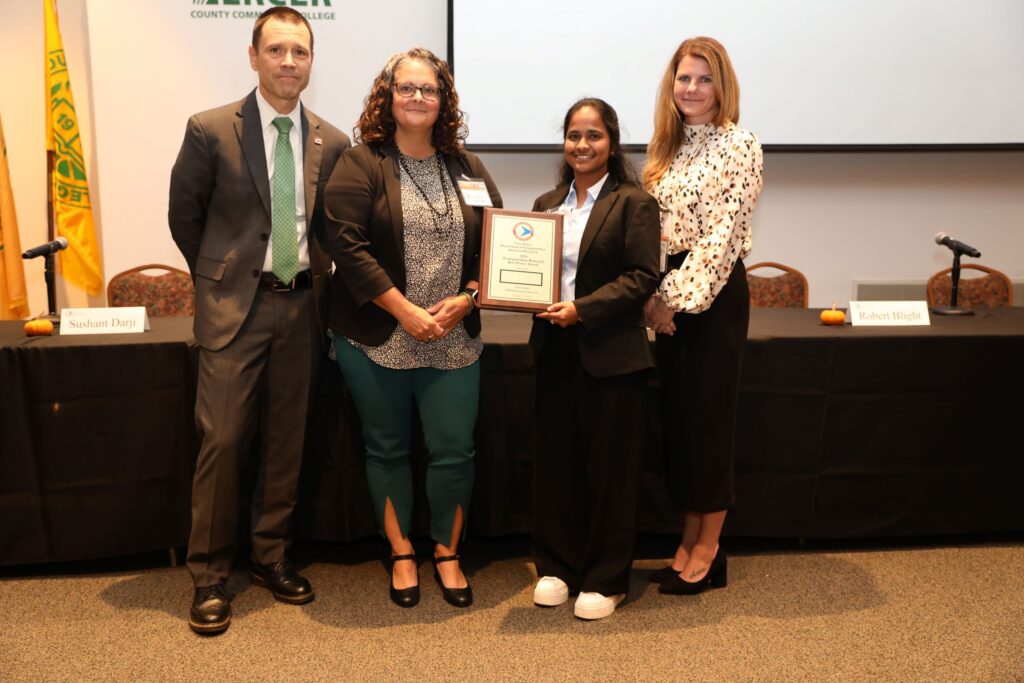
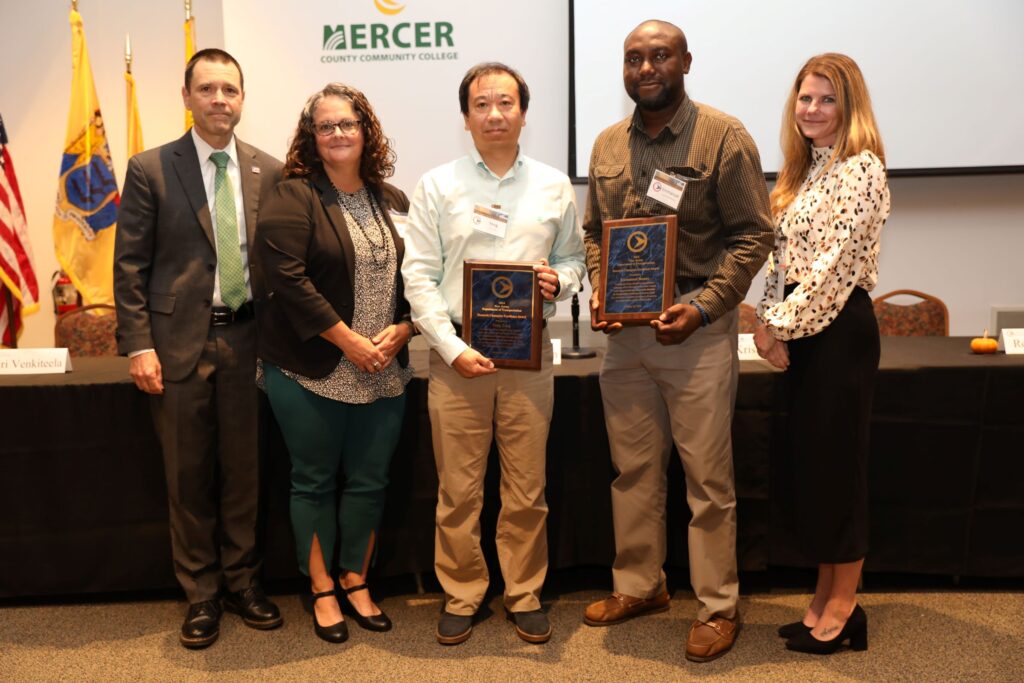

HIGH VALUE RESEARCH
In addition to the awards announced and distributed by NJDOT for the 26th Annual NJDOT Research Showcase, the event highlighted two NJDOT research projects that were recognized with 2024 AASHTO National High Value Research Awards at the Research Advisory Committee (RAC) national meeting in Columbus, Ohio in late July 2024.
Advanced Reinforced Concrete Materials for Transportation Infrastructure. One of only 16 research projects nationwide to receive the 2024 AASHTO National High Value Research Award, this project evaluated the performance of three highly ductile concrete materials in comparison to two standard NJDOT mixtures. The results of the research can be used to guide best practices around deploying novel concrete materials to improve the service life of reinforced concrete infrastructure. Principal Investigators: Dr. Matthew Bandelt and Dr. Matthew Adams of New Jersey Institute of Technology; Technical Advisory Panel: Yong Zeng, Nehemie Jasmin, Emmanuel Bassey; Research Project Manager: Dr. Giri Venkiteela of NJDOT BRIIT.
Innovative Pothole Repair Materials and Techniques. This research project tested several new pothole repair materials and techniques including the use of recycled asphalt pavement (RAP) and PVA fibers. The research findings can be used to produce longer lasting and more sustainable roadways. The research project received a Supplementary National High Value Research Award from the AASHTO RAC. Principal Investigators: Dr. Hao Wang and Dr. Husam Najm at Rutgers-CAIT; Technical Advisory Panel: Sadime Absolam, Jeff Evanylo, Emmanuel Bassey, Kenrick Layne, Nicholas Colangelo, Anupkumar Patel, Roger Estivalletti, Yong Zeng; Research Project Manager: Dr. Giri Venkiteela of NJDOT BRIIT.
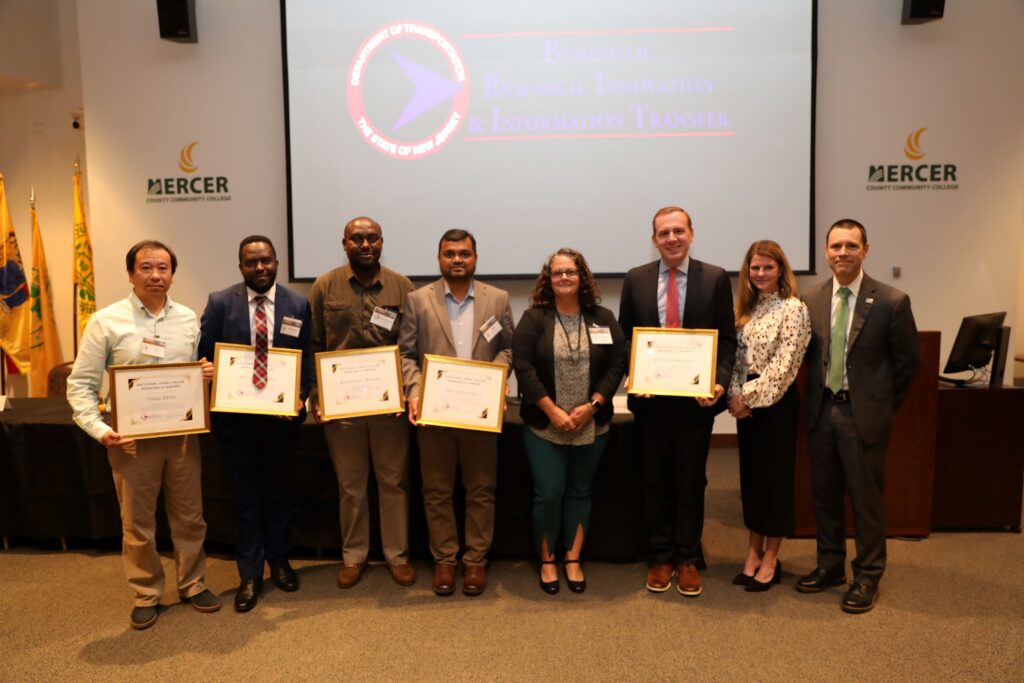

AFTERNOON
In the afternoon, concurrent break-out sessions were held and research presentations were given on the topics of Infrastructure, Sustainability and Safety. Students and researchers at New Jersey’s colleges and universities also presented their research objectives, methods and findings in a concurrent poster session offering those in attendance an opportunity to learn more about ongoing and recently completed research and interact with the researchers.
INFRASTRUCTURE BREAKOUT
SUSTAINABILITY BREAKOUT
SAFETY BREAKOUT
2024 POSTER PRESENTATIONS


The 26th Annual Research Showcase was organized and sponsored by the NJDOT Bureau of Research in partnership with the New Jersey Local Technical Assistance Program (NJ LTAP) at the Rutgers Center for Advanced Infrastructure and Transportation (CAIT) and co-sponsored by the Federal Highway Administration.






